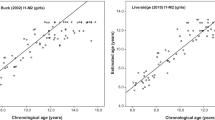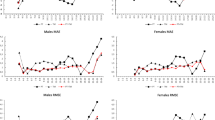Abstract
The prevalence of developmental asymmetry between left and right sides of the body in the third molar tooth and medial clavicular epiphysis is examined in a contemporary Australian population (92% Caucasian). The contention that differences between left and right side developmental timing is statistically insignificant, and can therefore be ignored in forensic age estimation procedures, is questioned. It was found that of a population sample of 604 individuals, 177 displayed asymmetrical timing in development between antimeres of the third molar, the medial clavicle or both. There was no correlation found between the third molar tooth and medial clavicular epiphysis in terms of left/right synchronicity. For those individuals differing in development by two or more developmental stages in either age marker or one stage in both age markers, the effect upon the accuracy of forensic age estimations can be significant. Differences in age estimates for each side were as much as 3.1 years. Age estimations based on one side only may not provide the best estimate for an individual, and more accurate results can be achieved if both sides are taken into consideration. A protocol for dealing with asymmetrical development is discussed with reference to the multifactorial age estimation method proposed by the same authors in previous research.

Similar content being viewed by others
References
Demirjian A, Goldstein H, Tanner JM (1973) A new system of dental age assessment. Hum Biol 45(2):211–227
Mckern TW, Stewart TD (1957) Skeletal age changes in young American males analysed from the standpoint of identification. Natick, Massachusetts, Headquarters, Quartermaster Research & Development Command
Webb PA, Suchey JM (1985) Epiphyseal union of the anterior iliac crest and medial clavicle in a modern multiracial sample of American males and females. Am J Phys Anthropol 68(4):457–466
Greulich WW, Pyle SI (1959) Radiographic atlas of skeletal development of the hand and wrist, 2nd edn. Stanford University Press, California
Tanner JM, Whitehouse RH, Marshall WA, Healy MJR, Goldstein H (1975) Assessment of skeletal maturity and prediction of adult height (tw2 method). Academic, New York
Moorrees CF, Fanning EA, Hunt EE Jr (1963) Age variation of formation stages for ten permanent teeth. J Dent Res 42:1490–1502
Olze A, Taniguchi M, Schmeling A, Zhu BL, Yamada Y, Maeda H et al (2003) Comparative study on the chronology of third molar mineralization in a Japanese and a German population. Leg Med (Tokyo) 5(Suppl 1):S256–S260
Orhan K, Ozer L, Orhan AI, Dogan S, Paksoy CS (2007) Radiographic evaluation of third molar development in relation to chronological age among Turkish children and youth. Forensic Sci Int 165(1):46–51
Cardoso HF (2008) Age estimation of adolescent and young adult male and female skeletons II, epiphyseal union at the upper limb and scapular girdle in a modern Portuguese skeletal sample. Am J Phys Anthropol 137(1):97–105
Cardoso HF (2007) Environmental effects on skeletal versus dental development: using a documented subadult skeletal sample to test a basic assumption in human osteological research. Am J Phys Anthropol 132(2):223–233
Kellinghaus M, Schulz R, Vieth V, Schmidt S, Schmeling A (2010) Forensic age estimation in living subjects based on the ossification status of the medial clavicular epiphysis as revealed by thin-slice multidetector computed tomography. Int J Legal Med 124(2):149–154
Schulz R, Muhler M, Reisinger W, Schmidt S, Schmeling A (2008) Radiographic staging of ossification of the medial clavicular epiphysis. Int J Legal Med 122(1):55–58
Kasper KA, Austin D, Kvanli AH, Rios TR, Senn DR (2009) Reliability of third molar development for age estimation in a Texas Hispanic population: a comparison study. J Forensic Sci 54(3):651–657
Blenkin MR, Evans W (2011) Age estimation from the teeth using a modified Demirjian system. J Forensic Sci 55(6):1504–1508
Graham JP, O’Donnell CJ, Craig PJ, Walker GL, Hill AJ, Cirillo GN et al (2010) The application of computerized tomography (CT) to the dental ageing of children and adolescents. Forensic Sci Int 195(1–3):58–62
Schmeling A, Grundmann C, Fuhrmann A, Kaatsch HJ, Knell B, Ramsthaler F et al (2008) Criteria for age estimation in living individuals. Int J Legal Med 122(6):457–460
Mincer HH, Harris EF, Berryman HE (1993) The A.B.F.O. study of third molar development and its use as an estimator of chronological age. J Forensic Sci 38(2):379–390
Cunha E, Baccino E, Martrille L, Ramsthaler F, Prieto J, Schuliar Y et al (2009) The problem of aging human remains and living individuals: a review. Forensic Sci Int 193(1–3):1–13
Garamendi PM, Landa MI, Ballesteros J, Solano MA (2005) Reliability of the methods applied to assess age minority in living subjects around 18 years old. A survey on a Moroccan origin population. Forensic Sci Int 154(1):3–12
Bassed RB, Hill AJ (2011) The use of computed tomography (CT) to estimate age in the 2009 Victorian bushfire victims: a case report. Forensic Sci Int 205(1–3):48–51
Johanson G (1971) Age determinations from human teeth, a critical evaluation with special consideration of changes after fourteen years of age (Odontol revy v.22. supplement). Gleerup, Allingabro
Bhat VJ, Kamath GP (2007) Age estimation from root development of mandibular third molars in comparison with skeletal age of wrist joint. Am J Forensic Med Pathol 28(3):238–241
Meinl A, Tangl S, Huber C, Maurer B, Watzek G (2007) The chronology of third molar mineralization in the Austrian population—a contribution to forensic age estimation. Forensic Sci Int 169(2–3):161–167
Prieto JL, Barberia E, Ortega R, Magana C (2005) Evaluation of chronological age based on third molar development in the Spanish population. Int J Legal Med 119(6):349–354
Kullman L, Martinsson T, Zimmerman M, Welander U (1995) Computerized measurements of the lower third molar related to chronologic age in young adults. Acta Odontol Scand 53(4):211–216
Kullman L, Johanson G, Akesson L (1992) Root development of the lower third molar and its relation to chronological age. Swed Dent J 16(4):161–167
Willershausen B, Loffler N, Schulze R (2001) Analysis of 1202 orthopantograms to evaluate the potential of forensic age determination based on third molar developmental stages. Eur J Med Res 6(9):377–384
Thevissen PW, Pittayapat P, Fieuws S, Willems G (2009) Estimating age of majority on third molars developmental stages in young adults from Thailand using a modified scoring technique. J Forensic Sci 54(2):428–432
Schulz R, Muhler M, Mutze S, Schmidt S, Reisinger W, Schmeling A (2005) Studies on the time frame for ossification of the medial epiphysis of the clavicle as revealed by ct scans. Int J Legal Med 119(3):142–145
Kreitner KF, Schweden FJ, Riepert T, Nafe B, Thelen M (1998) Bone age determination based on the study of the medial extremity of the clavicle. Eur Radiol 8(7):1116–1122
Schmeling A, Schulz R, Reisinger W, Muhler M, Wernecke KD, Geserick G (2004) Studies on the time frame for ossification of the medial clavicular epiphyseal cartilage in conventional radiography. Int J Legal Med 118(1):5–8
De Salvia A, Calzetta C, Orrico M, De Leo D (2004) Third mandibular molar radiological development as an indicator of chronological age in a European population. Forensic Sci Int 146(Suppl):S9–S12
Gorgani N, Sullivan RE, DuBois L (1990) A radiographic investigation of third-molar development. ASDC J Dent Child 57(2):106–110
Levesque GY, Demirijian A, Tanguay R (1981) Sexual dimorphism in the development, emergence, and agenesis of the mandibular third molar. J Dent Res 60(10):1735–1741
Nortje CJ (1983) The permanent mandibular third molar. Its value in age determination. J Forensic Odontostomatol 1(1):27–31
Olze A, Bilang D, Schmidt S, Wernecke KD, Geserick G, Schmeling A (2005) Validation of common classification systems for assessing the mineralization of third molars. Int J Legal Med 119(1):22–26
Schulz R, Zwiesigk P, Schiborr M, Schmidt S, Schmeling A (2008) Ultrasound studies on the time course of clavicular ossification. Int J Legal Med 122(2):163–167
Mesotten K, Gunst K, Carbonez A, Willems G (2003) Chronological age determination based on the root development of a single third molar: a retrospective study based on 2513 OPGs. J Forensic Odontostomatol 21(2):31–35
Cameriere R, Ferrante L, De Angelis D, Scarpino F, Galli F (2008) The comparison between measurement of open apices of third molars and Demirjian stages to test chronological age of over 18 year olds in living subjects. Int J Legal Med 122(6):493–497
Knell B, Ruhstaller P, Prieels F, Schmeling A (2009) Dental age diagnostics by means of radiographical evaluation of the growth stages of lower wisdom teeth. Int J Legal Med 123(6):465–469
Baer MJ, Djrkatz J (1957) Bilateral asymmetry in skeletal maturation of the hand and wrist: a roentgenographic analysis. Am J Phys Anthropol 15(2):181–196
Fazekas IG, Kosa F (1978) Forensic fetal osteology. Akademiai Kiado, Budapest
Albert AM, Greene DL (1999) Bilateral asymmetry in skeletal growth and maturation as an indicator of environmental stress. Am J Phys Anthropol 110(3):341–349
Dreizen S, Spirakis CN, Stone RE (1967) A comparison of skeletal growth and maturation in undernourished and well-nourished girls before and after menarche. J Pediatr 70(2):256–263
Rios L, Cardoso HF (2009) Age estimation from stages of union of the vertebral epiphyses of the ribs. Am J Phys Anthropol 140(2):265–274
Steele J (2000) Skeletal indicators of handedness. In: Cox M, Mays S (eds) Human osteology in archaeology and forensic science. Cambridge University Press, Cambridge, pp 307–323
Bassed RB, Briggs C, Drummer OH (2011) Age estimation and the developing third molar tooth: an analysis of an Australian population using computed tomography. J Forensic Sci 56(5):1185–1191
Bassed RB, Drummer OH, Briggs C, Valenzuela A (2011) Age estimation and the medial clavicular epiphysis: analysis of the age of majority in an Australian population using computed tomography. Forensic Sci Med Pathol 7(2):148–154
Bassed RB, Briggs C, Drummer OH (2011) Age estimation using CT imaging of the third molar tooth, the medial clavicular epiphysis, and the spheno-occipital synchondrosis: a multifactorial approach. Forensic Sci Int. doi:10.1016/j.forsciint.2011.06.007
Martin-de las Heras S, Garcia-Fortea P, Ortega A, Zodocovich S, Valenzuela A (2008) Third molar development according to chronological age in populations from Spanish and Magrebian origin. Forensic Sci Int 174(1):47–53
Olze A, Schmeling A, Taniguchi M, Maeda H, van Niekerk P, Wernecke KD et al (2004) Forensic age estimation in living subjects: the ethnic factor in wisdom tooth mineralization. Int J Legal Med 118(3):170–173
Olze A, van Niekerk P, Ishikawa T, Zhu BL, Schulz R, Maeda H et al (2007) Comparative study on the effect of ethnicity on wisdom tooth eruption. Int J Legal Med 121(6):445–448
Schmeling A, Olze A, Reisinger W, Geserick G (2005) Forensic age estimation and ethnicity. Leg Med (Tokyo) 7(2):134–137
Schmeling A, Olze A, Reisinger W, Konig M, Geserick G (2003) Statistical analysis and verification of forensic age estimation of living persons in the Institute of Legal Medicine of the Berlin University Hospital Charite. Leg Med (Tokyo) 5(Suppl 1):S367–S371
Thevissen PW, Fieuws S, Willems G (2010) Human third molars development: comparison of 9 country specific populations. Forensic Sci Int 201(1–3):102–105
Thevissen PW, Alqerban A, Asaumi J, Kahveci F, Kaur J, Kim YK et al (2010) Human dental age estimation using third molar developmental stages: accuracy of age predictions not using country specific information. Forensic Sci Int 201(1–3):106–111
Author information
Authors and Affiliations
Corresponding author
Rights and permissions
About this article
Cite this article
Bassed, R.B., Briggs, C. & Drummer, O.H. The incidence of asymmetrical left/right skeletal and dental development in an Australian population and the effect of this on forensic age estimations. Int J Legal Med 126, 251–257 (2012). https://doi.org/10.1007/s00414-011-0621-2
Received:
Accepted:
Published:
Issue Date:
DOI: https://doi.org/10.1007/s00414-011-0621-2




